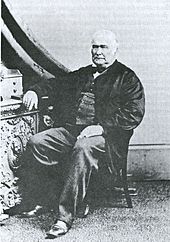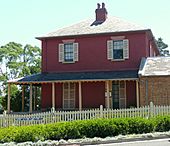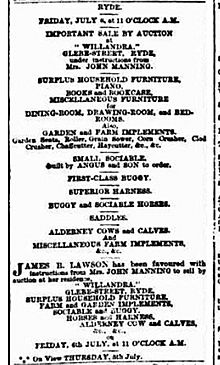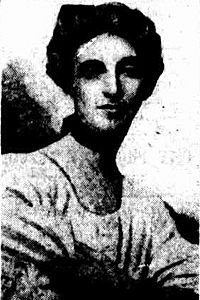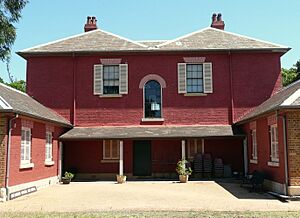Willandra, Ryde facts for kids
Quick facts for kids Willandra |
|
|---|---|
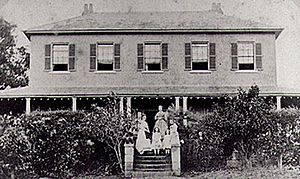
Willandra, Ryde around 1870, when the Devlin family lived there.
|
|
| Location | 782 Victoria Road, Ryde, New South Wales, Australia |
| Built | 1841–1844 |
| Architect | William Weaver (attrib.) |
| Architectural style(s) | Colonial Georgian |
| Owner | City of Ryde |
| Official name: Willandra; Ryde House | |
| Type | State heritage (complex / group) |
| Designated | 2 April 1999 |
| Reference no. | 26 |
| Type | Homestead building |
| Category | Residential buildings (private) |
| Builders | James Devlin |
| Lua error in Module:Location_map at line 420: attempt to index field 'wikibase' (a nil value). | |
Willandra is a special historic house in Ryde, New South Wales, Australia. It was once a family home and later a service station. Today, it is a community center. The house was built between 1841 and 1844 by James Devlin. Its design is thought to be by William Weaver.
Willandra is also known as the Ryde House. It is built in the Colonial Georgian style. The City of Ryde council now owns the property. In the 1970s, the house was almost torn down. Luckily, the council bought it with help from the Australian Government. Willandra was then restored and is now used by local community groups. It was added to the New South Wales State Heritage Register on April 2, 1999.
Willandra's Story
The Ryde area was perfect for farming and growing fruit. Early land grants were given to soldiers to encourage farming. In 1792, land was given to eight soldiers. Later, twelve grants were made to convicts. Important people like John Macarthur and Gregory Blaxland later bought much of this land. The area remained a key fruit-growing region throughout the 1800s.
The grants in the Ryde area were first called Eastern Farms. Later, they were known as Kissing Point. This name came from a rock shelf in the Parramatta River. At low tide, boat bottoms would "kiss" the rock. The whole area, including where Willandra stands, became known as Kissing Point.
The Devlin Family and Ryde House
The land where Willandra was built was first given to John Small in 1794. James Devlin acquired it in 1828. James was born in New South Wales in 1808. His father, Arthur Devlin, was an Irish exile. Arthur came to Sydney as an exile, not a convict, after a rebellion in Ireland. James's mother, Priscilla Squire, was the daughter of James Squire, a well-known landowner and brewer from Kissing Point.
James Devlin inherited some of James Squire's wealth. He also received the land from his stepfather, Thomas Small. In the early 1840s, James felt confident enough to start building a grand house. This was during a tough economic time in New South Wales. He had to mortgage the property soon after it was finished. However, he managed to keep his home, unlike many others.
At that time, there were few buildings nearby. The local church, St. Anne's, was small. The rector's wife, Mrs. Turner, thought the area looked like her home in the Isle of Wight. She started calling it "Ryde." James Devlin named his new house "Ryde House." In 1841, the local Post Office also adopted the name Ryde.
James Devlin started as a wheelwright, making and repairing wheels. He later became a pound-keeper and postmaster. He then became a successful developer and builder. When Ryde House was built, Governor Sir George Gipps was in charge of NSW. Devlin chose the Georgian style, even though Queen Victoria had been queen since 1837.
The name "Ryde" became common around 1840. James Devlin and his neighbor, James Shepherd, surveyed land for a new "Village of Ryde." Devlin's "East Ryde" faced the church, and Shepherd's "West Ryde" faced the road to Parramatta. Devlin's new Ryde House sat proudly on the ridge between these two areas.
The Devlin family moved into Willandra in 1845. James Devlin faced financial difficulties in 1844 but recovered in 1845. The family lived there for almost 30 years. In 1874, they sold the house and moved to Wagga Wagga, New South Wales.
William Weaver, an architect, lived in Ryde from 1856 to 1858. He was the Colonial Architect for a time. Willandra looks similar to some of his other house designs.
James Devlin became a magistrate in Ryde from 1864 to 1872. He also helped create the Municipality of Ryde in 1871. He was elected as an alderman, a local council member. Devlin's Creek and Devlin Street are named after him.
When James Devlin sold Ryde House in 1874, it was described as a "commodious family mansion" with 12 rooms, a magnificent garden, orchard, and orangery. It had "the purest water" and "the most extensive and beautiful view." James Devlin died in 1875. His wife, Susannah, lived to be 98 years old, passing away in 1907.
Caroline and John Edye Manning
Caroline Manning owned Willandra from 1879 until she died in 1921. She lived in the house until 1894. Caroline Elizabeth Mary Suttor was born in 1841. Her father, William Henry Suttor, was a wealthy landowner and politician. Willandra was bought for Caroline through her father's will.
John Edye Manning was a merchant. He and Caroline married in 1859 and had thirteen children. One of their sons, Reginald Kerr Manning, went to school at Newington College on the Parramatta River.
In 1894, John Edye Manning faced personal difficulties. Soon after, Caroline advertised Willandra for rent. The advertisement mentioned "Willandra," showing that the Mannings were the ones who changed the house's name from "Ryde House." The ad described it as a "most comfortable family residence" with 18 rooms, stables, tennis lawns, and gardens.
After renting out the house, the Manning family moved to England. John Edye Manning died in 1909, and Caroline died in 1921. The name "Willandra" is thought to come from an Aboriginal word meaning "rushing water." This name became popular in the area, especially when Willandra Street was named in 1925.
Ellen Pye and Rydalmount School
Ellen Pye rented Willandra from Caroline Manning from 1894 to 1899. She turned the house into a boarding and day school for girls called Rydalmount. An advertisement for the school described Willandra as being on a "magnificent site of 30 acres." It had "extensive and picturesque views" of the Parramatta River. The school also had large playgrounds, gardens, a tennis court, orchard, and vineyard. The rooms were "lofty and well ventilated," perfect for a school.
Ellen Blundell Pye was born in England in 1860. She moved to Australia in 1883. By 1890, she was the Principal of St Anne's School in Ryde. In 1894, she started her own school at Willandra. The school even organized a fete to raise money for the Children's Hospital.
Ellen ran Rydalmount at Willandra until 1899. She then moved to Victoria to become Principal of Toorak College. She retired due to health issues and later returned to England, where she died in 1948 at age 88.
Later Owners and Service Station Era
After Miss Pye left, Willandra had several renters and owners. These included John Melliday, Augustus Cook, and John T Craig. Caroline Manning died in 1921, and the house was sold. Owners included George Henry Nash (1926-1932), Rowland Wesley Small (1932-1945), and Kenneth Roy Bernard-Smith (1945-1951).
From 1951 to 1976, Willandra was used as a service station or car repair shop. In 1932, an owner named Roland Small installed a petrol pump for his own use. Its location attracted other car users. Later, a garage and motor trimming shop were built.
In the 1950s, Shell Australia bought the property. They turned the garage into a full service station. This operated until 1970. Then, Mr. Hooper bought it and opened a second-hand car yard. Parts of the house were rented out to people living there.
Saving Willandra
By the 1970s, Willandra was in poor condition. It was even threatened with demolition. The Ryde & District Historical Society and other groups worked hard to save it. They lobbied the Ryde City Council and the government.
In 1973-74, the Australian Government gave a grant of $100,000. This was part of the first national program to protect Australia's heritage. Willandra was one of the first six properties in New South Wales to get this funding. This money helped the Ryde Council buy the property in 1974 for $85,600.
Tom Uren, a Federal Minister, was very helpful in getting this grant. The New South Wales Government also provided funds. In 1979, a permanent conservation order was placed on Willandra, protecting it by law.
Willandra's Restoration (1979-1980)
The architect for the restoration was Clive Lucas. The builder was Gledhill Constructions. Willandra was in bad shape. A taxi radio mast on the roof had caused water damage inside. Windows and wooden parts were rotting.
One big job was fixing the drainage to stop water from getting under the house. They also carefully repaired floors, using wood from larger rooms for smaller ones. Original cedar doors and marble fireplaces had been stolen but were recovered thanks to a neighbor.
During restoration, a stenciled pattern was found on the hall walls. This design was recreated. The front door is unique, with a semi-circular shape and glass triangles. The house was designed to be perfectly symmetrical. The restoration brought it back to this original look.
The outside of the house was painted a deep terracotta color. This was the main color found by the restorers, though many people remembered it as cream. The Ryde Rotary Club helped with the landscaping. They removed a large concrete area and planted ivy, plumbago, and two peppercorn trees.
After restoration, Willandra reopened. The Ryde District Historical Society and the City of Ryde Art Society became its tenants. It is used as a local museum, art gallery, and for classes. Willandra is open to the public on weekends. Clive Lucas & Partners even won an award for their work on the house.
In the 1990s, new road works changed the area around Willandra. Devlin Street was moved, and some old buildings were demolished. This separated Willandra from the old Ryde village. However, the house still stands proudly on its elevated site.
Willandra was officially added to the State Heritage Register on April 2, 1999. Today, the Ryde District Historical Society mainly manages Willandra.
Willandra's Design and Features
Willandra's original land was much larger, about 30 acres. It was once in a rural setting but is now in a suburban area, next to busy roads. The house was built to face the Parramatta River, overlooking farmlands. Ryde Village grew up next to Willandra.
Today, Willandra is on a smaller site at a busy intersection. Surrounding buildings have changed its grand look. However, Willandra still stands tall and can be seen from a distance.
The Garden
The garden is much smaller than it used to be. It has a driveway, a stone retaining wall, and steps. There are lawns and some trees like Chinese elm and Moreton Bay fig. Some plants from the original restoration plan have died, but new ones like Kaffir lilies have been planted.
The back garden has two plaques. One celebrates Australia's 200th birthday in 1988. The other honors Bill Stacey, the first president of the Ryde District Historical Society.
The House
Willandra is a two-story house built in the Colonial Georgian Revival style. It has a hipped roof and deep eaves. The front has five sections with French doors downstairs and double sash windows upstairs. A decorative fanlight is above the front door. Stone-paved verandahs with stone columns surround the house.
The outside walls are made of rendered sandstock brickwork. Inside, ceilings are plastered, often with decorative cornices. The floors are made of blackbutt wood, kauri pine, or sandstone. The timber doors and windows are made from Australian cedar.
The kitchen still has its original wood-fueled stove. A wooden panel separates the dairy room from the kitchen.
Condition of the House
Willandra is generally in good condition and well-maintained. Some parts need repair, especially those from the 1979-80 restoration. Inside, walls and ceilings need repainting, and some wooden parts need refreshing.
There might be old outbuildings or a well on the property. However, road works and past changes to the site may have disturbed or covered these.
Why Willandra is Important
Willandra is very important to the history and culture of New South Wales and Ryde.
- Historical Importance: It shows how the colony of New South Wales was settled, especially in the Ryde area. It was part of an early land grant and became the center of the growing Village of Ryde. James Devlin, who built it, was a key figure in Ryde's development. He was a successful businessman, a magistrate, and helped establish the local council. Willandra was also owned by other important people like Caroline Manning. Its name, "Willandra," is believed to be an Aboriginal word for "rushing water."
- Architectural Beauty: Willandra is a beautiful and rare example of a Colonial Georgian house. It stands in a prominent spot in Ryde, with great views of the Parramatta River. Its strong, balanced design shows the style of homes built by important families in the past. Experts consider it one of the best Colonial Georgian houses remaining in Australia.
- Community Connection: Willandra is highly valued by the local community. It was a place for social events in the past. More recently, it became a symbol of community effort when people fought to save it from demolition. The Ryde District Historical Society and the Ryde Arts Society, who use the building today, hold it in high regard. It helps people understand Ryde's unique history and appreciate its beauty.
- Research Potential: Willandra can still teach us about the past. Its design and location show how grand homes were built and connected to the land and nearby towns. It has rare features, like sandstone columns turned from a single piece and a special geometric staircase made of cedar.
Willandra was listed on the New South Wales State Heritage Register on April 2, 1999, because of its significant historical, aesthetic, social, and research value.


